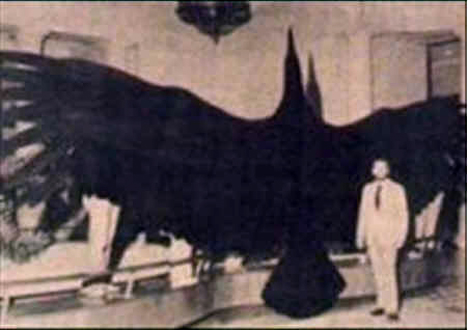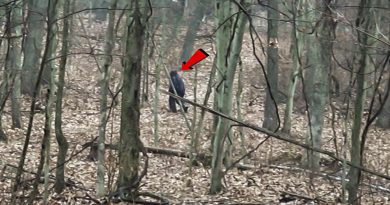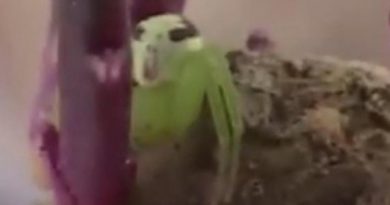Unexplained Mysteries of ThunderBird – LawnDale Incident
Source: http://en.wikipedia.org/wiki/Thunderbird_%28mythology%29
Thunderbird is a term used in cryptozoology to describe large, bird-like creatures, generally identified with the Thunderbird of Native American tradition. Similar cryptids reported in the Old World are often called Rocs. Thunderbirds are regarded by a small number of researchers as having lizard features like the extinct pterosaurs such as Pteranodon. Although reports of Thunderbird sightings go back centuries, due to the lack of scientific evidence (such as a fossil record), the creature is generally regarded as a myth.
One of the great mysteries of modern times has its roots in Arizona. This mystery involves a photograph of a so-called “Thunderbird” and a mysterious creature that was said to have been captured near the town of Tombstone.
The story goes that two cowboys sighted an enormous flying creature in in the Arizona desert in April 1890. The beast had the body of a serpent, immense wings, two clawed feet and the face of an alligator. The men got as close as their skittish horses would allow and then chased the bird on foot. It took off and landed a few times and the cowboys opened fire with rifles and killed the monster.
The enormous wingspan of the creature was said to have been 160 feet and the body was more than 92 feet long. It was smooth and featherless, more like a bat than a bird, and they cut off a piece of the wing and brought it with them into Tombstone, Arizona.
Or least that’s the story that was allegedly told in an April 1892 issue of the Tombstone newspaper, the Epitaph. This was the only mention of the story and it gave all of the appearances of the tall tales that were often written in the western newspapers of the era. What makes this story different though is that it has given rise to an odd modern legend.
The story was revived in 1930 in the book On the Old West Coast by Horace Bell and then 33 years later, a writer named Jack Pearl mentioned the story in the sensationalistic men’s magazine called Saga. Not only did he tell the story though, he went one step further and claimed that the Tombstone Epitaph had, in 1886, published a photograph of a huge bird nailed to a wall. The newspaper said that it had been shot by two prospectors and hauled into town by wagon. Lined up in front of the bird were six grown men with their arms outstretched, fingertip to fingertip. The creature measured about 36 feet from wingtip to wingtip.”
Then, in the September 1963 issue of Fate magazine, a writer named H.M Cranmer would state that not only was the story true, but the photo was published and had appeared in newspapers all over America. And Cranmer would not be the only one who remembered the photo. Eminent Fortean researcher Ivan T. Sanderson also remembered seeing the photo and in fact, even claimed to have once had a photocopy of it that he loaned to two associates, who lost it. The editors of Fate even came to believe that they may have published the photo in an earlier issue (the magazine started in 1948) but a search through back issues failed to reveal it. Meanwhile, the original Epitaph story (which mentions no photograph) was revived in a 1969 issue of Old West, further confusing the issue as to whether the photo was real or not!
The Epitaph however stated that it did not exist, or if it did, it had not been in their newspaper. Responding to numerous inquiries, employees of the paper started a thorough search of back issues and files. They could find not such photo and even an extended search of other Arizona and California newspapers of the period produced no results.
So, is the photo real? And if not, then why do so many of us (myself included) with an interest in the unusual claim to remember seeing it? Who knows? Just recently, in the late 1990’s, author John Keel insisted that â I know I saw it! And not only that – I compared notes with a lot of other people who saw it.” Like many of us, Keel believes that he saw it in one of the men’s magazines (like Saga or True) that were so popular in the 1960’s. Most of these magazines dealt with amazing subject matter like Bigfoot, ghosts and more. Keel also remembers the photo in the same way that most of us do.. with men wearing cowboy clothing and the bird looking like a pterodactyl or some prehistoric, winged creature.
Interestingly, Keel’s writings prompted a memory from W. Ritchie Benedict, who recalled seeing Ivan T. Sanderson display the photo on a Canadian television show. Unfortunately though, no copies of the show have ever been found.
During the 1990’s, the search for the “Thunderbird Photo” reached a point of obsession for those interested in the subject. A discussion of the matter stretched over several issues of Mark Chorvinsky’s excellent Strange magazine and readers who believed they had seen the photo cited sources that ranged from old books, to Western photograph collections, men’s magazines and beyond. As for myself, I combed through literally hundreds of issues of dusty copies of True and Saga but could find nothing more than the previously mentioned article by Jack Pearl.

Although viewed by some as a tall tale, the descriptions given by the witnesses of these birds describe a large black bird, with a white ring on its neck and a wingspan of up to 10 feet, traits oddly reminiscent of the Andean condor (Vultur gryphus) which exhibits the same basic physical characteristics as that of the Lawndale bird. To this day, no one can explain away the incident from 1977 in any convincing manner, either the incident didn’t happen or a large bird (of known or unknown status) attacked and carried a small boy one summer night to his and his family’s terror.
The evidence thus far for the existence of a large undescribed predatory bird in North America is based on historical and modern anecdotal evidence with no physical evidence. There are however two tantalizing images of the Thunderbird, or at least of a large bird. The first was taken in the same year as Marlon Lowe’s attack and in the same state. On July 30, 1977 John Huffer, an ex-marine and photographer, took a 100 foot roll of color film of two birds taking off from a tree in an inlet of Lake Shelbyville. The film concentrates on one of the birds only. Highly controversial, and thought by many to be of a turkey vulture, it sits as a little known film of a possible mystery animal. To date little, if any, evaluation of the birds in the film has been done. The Discovery Channel in their program “Into the Unknown” did give the film some mention, with a dismissal of a medium sized bird, probably a vulture.
The other possible photographic evidence is even more of a mystery, as it may not exist at all!! The image in question is the “Thunderbird Photograph” taken at the end of the nineteenth century in Texas. The image is said to depict six western clothed adult men, standing fingertip to fingertip in front of a barn where a large bird is nailed to the wall. Many have claimed to have seen or held this infamous image, including the late Ivan T. Sanderson who reportedly had acquired a photocopy of the image in 1966, the same year in which Sanderson gave the image, later lost, to a couple of men from Pennsylvania who were searching for the Thunderbird. The image has yet to surface, and may well not exist at all.
The image was reported to have been published in 1886 in the Tombstone Arizona Epitaph, however this was somewhat dubiously reported in a 1963 article by Jack Pearl called “The Monster Bird That Carries Off Human Beings!” in Saga magazine. Searches of the Tombstone Epitaph have come up empty, aside from an article from April 26, 1890 of a 16 foot bird found in the desert by a couple of ranchers. So the mystery of the “Thunderbird Photo” is no closer to being solved then it was nearly 40 years ago during its first mention.
What then is the Thunderbird? It is a mystery. It has been reported by Native Americans and people today from all walks of life as an enormous bird, larger than any known species, but similar in appearance to a condor. Theories as to what the Thunderbird may be have run the gamut from surviving pterodactyls to the teratorns. The teratorns were large predatory birds from the Pleistocene that exhibited wingspans of upwards of 25 feet. Although thought to be extinct, their general presumed appearance is that of a giant condor-like species, similar in appearence to the Thunderbird. North America has many mysteries, among them the Thunderbird. These creatures are surely one of the most enigmatic cryptids in the world. With misinformation abounding, such as the “Thunderbird Photograph,” and the lack of support in searching for these birds, it is no wonder that these creatures have evaded discovery like so many others from around the world.




The late Jerry Mazinsky (sp?) researched Thunderbird sightings in North Central Pennsylvania and interviewed several people. He spoke to some groups and wrote some articles. He claimed to have seen a bird himself from a dirt road northwest of Coudersport, PA. This occurred about 20 years ago. I met after a canoe trip a science teacher who had canoed also a section of Pine Creek in Pennsylvania’s Grand Canyon. He claimed to have seen what he first thought was a plane when he was hiking on the Donut Hole Trail. He realized that it was a bird but much larger than any eagle. He had seen many eagles. A writer whose last name was Lyman wrote of stories and personal accounts in that part of PA.
He had claimed to come upon the bird sitting on a road near Coudersport. The bird rose and flew. He claimed the wignspan seemed to be as wide as the road, and, though admitting that shock might have enlarged what he thought he saw, he got of his vehicle and measured the road to be about 20-feet wide. I regret I no longer have specific references to offer. I did know Jerry and can say that he was no charlatan.